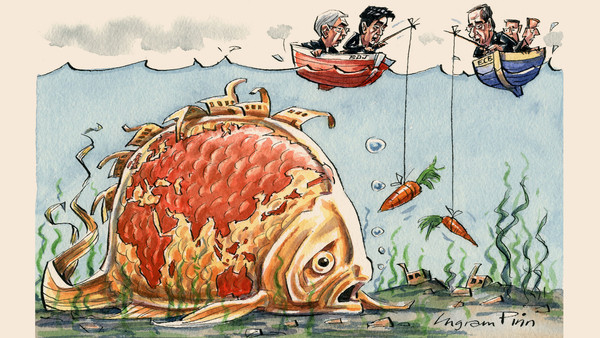David Cameron, the UK prime minister, states that “red warning lights are once again flashing on the dashboard of the global economy”. The lights are not as red as in 2008. Nevertheless, the difficulties caused by the fiscal austerity that his government recommends have become particularly evident in Japan and the eurozone. These stagnant high-income economies are the weakest links in the world economy. To understand why, one needs to analyse today’s most important economic illness: chronic demand deficiency syndrome.
英国首相戴维•卡梅伦(David Cameron)声称,“在全球经济的仪表板上,红色警示灯又亮了起来”。这次信号灯没有2008时那样红。然而,财政紧缩——卡梅伦政府也提出实施紧缩政策——引起的困难在日本和欧元区表现得特别明显。这两个停滞的高收入经济体是全球经济中最薄弱的环节。要理解个中缘由,有必要分析当前经济中最重要的病症:慢性需求不足综合征。

Jack Lew, US Treasury secretary, provided a sobering overview in a speech delivered in Seattle, en route to last weekend’s summit of the group of 20 leading high-income economies in Australia. As he noted, the world is far from achieving the “strong, sustainable, and balanced” growth, promised at the 2009 summit in Pittsburgh.
最近,美国财长杰克•卢(Jack Lew)去澳大利亚参加全球20个主要高收入经济体的峰会。他在途经西雅图时发表了一次演说,他对当前形势的概述令人警醒。正如他所指出的,世界经济远未实现2009年匹兹堡G20峰会承诺的“强劲、可持续、平衡的”增长。
Global recovery has been “uneven, with sharply different trajectories,” he said. “In the US, domestic demand surpassed pre-crisis levels in the first quarter of 2012 and is now about 6 per cent higher than before the crisis. Domestic demand in both Japan and the UK is about 2 per cent higher,” he added. “But demand in the eurozone has yet to recover the ground lost during the crisis, remaining more than 4 per cent below its pre-crisis level.”
全球复苏是“不平衡的,呈现大不相同的轨迹,”他说。“在美国,2012年一季度内需已超过危机前的水平,目前大约比危机前高了6%。日本和英国的内需都比危机前高约2%,”他补充道,“但是,欧元区需求尚未恢复至危机前水平,仍比那时低4%以上。”
What Mr Lew did not add is that this feeble performance – even the 6 per cent rise in real demand in the US over more than six years is pathetic by historical standards – occurred despite the most aggressive monetary policies in history. The official intervention rates of the US Federal Reserve, the European Central Bank and the Bank of England have been not far above zero since late 2008. The ECB struggled to raise rates above 1 per cent in 2011, but then succumbed to the pull of near zero. The Bank of Japan has been offering near zero rates for two decades.
杰克•卢没有说的是,这一疲软表现——以历史标准衡量,美国实际需求在6年多时间里增加6%都是很差劲的——产生的背景是,全球各主要央行实施了史上最积极的货币政策。自2008年末以来,美联储(Fed)、欧洲央行(ECB)、英国央行(BoE)的官方干预利率都一直略高于零。2011年,欧洲央行曾勉为其难地把利率提高到1%以上,但随后又不得不调回至零附近。过去20年里,日本央行(BoJ)执行的利率一直接近于零。
Yet this has not been nearly enough. All these central banks have increased their balance sheets sharply. In the US and UK, the balance sheet expansion has stabilised. In the eurozone, the contraction since 2012 is being reversed, while the Bank of Japan’s balance sheet is heading towards the economic stratosphere, at 80 per cent of gross domestic product and counting.
不过,这么做还远远不够。这些央行都大幅扩张了各自的资产负债表。在美国和英国,央行资产负债表的扩张已稳定下来。在欧元区,自2012年来的收缩正在发生逆转,日本央行的资产负债表规模与国内生产总值(GDP)的比例已达到80%的极高水平,且在继续升高。
How do we explain such weak demand, particularly in the eurozone and Japan? Only if we understand this do we have any hope of deciding on the right remedies. One can identify three sets of underlying explanations.
那么我们该如何解释为何需求会如此疲弱,尤其是在欧元区和日本?只有理解这一点,我们才有希望对症下药。我们可以归纳出三种基本解释。
The first set stresses the post-crisis overhang of private debt and the damage to confidence caused by the sudden disintegration of the financial system. The by-now canonical response consists of cleaning up balance sheets and forced injection of capital into the banking system, supported by stress tests, to convince the public that the financial system is again creditworthy. To this should be added fiscal and monetary support for demand. In this view, a return to growth should be swift.
第一种解释强调后危机时期的巨额私人债务,以及金融体系突然崩溃对信心的伤害。到目前为止的典型对策,包括清理资产负债表,强行向金融体系注资,并辅以银行压力测试,以使公众相信,金融体系如今又是可信的。在此基础上,还应从财政和货币方面支持需求。按照这种解释,恢复增长应该是很迅速的。
The second set of explanations denies this last proposition. It argues that the pre-crisis demand was unsustainable because it relied on huge accumulations of private and public debt – the former associated with bubbles in property prices. Japan suffered such a post-bubble reversal in private debt accumulation after 1990; the US, UK and Spain after 2008. The implication of this is that economies suffer not just from a post-crisis balance-sheet recession, but from an inability to generate credit-driven demand on the pre-crisis scale. Behind the unsustainability of pre-crisis demand lie global imbalances, shifts in income distribution and structurally weak investment. A symptom is a chronic financial surplus (excess of income over spending) in the private sector, as in Japan and the eurozone.
第二种解释否认了上述看法。它认为,危机前的需求是不可持续的,因为当时需求依赖于私人和公共债务的积累——其中前者与房地产泡沫息息相关。日本在1990年后经历了泡沫破裂后私人债务积累的逆转;美国、英国和西班牙在2008年后也发生了这种情况。其后果在于,各经济体不但受困于后危机时期的资产负债表萎缩,而且苦于在后危机时期不能产生像危机前那么高的、由信贷驱动的需求。危机前需求的不可持续,其根源在于全球失衡、收入分配的变化,以及结构性的投资疲软。一种症状就是私人部门长期资金过剩(指收入高于支出的部分),就像日本和欧元区那样。
The third set of explanations points to a slowdown in potential growth, due to some combination of demographic changes, slowing rises in productivity and weak investment. But this last set of explanations feeds directly into the second. If growth of potential supply is expected to slow, consumption and investment will be weak. That will generate feeble growth in demand. If central banks fight this, they get bubbles. If they accept it, weak growth of supply turns into a self-fulfilling prophecy.
第三种解释指向了潜在增长率的放缓,其原因在于人口结构变化、生产率增长放慢和投资不足。但是,这最后一种解释,直接为第二种提供了支持。如果潜在供给增速预计将放缓,消费和投资也将变弱。这将造成需求增长缓慢。如果央行采取对策扭转这一状况,则将催生泡沫。如果央行接受这一状况,则供给增长疲软会变成自我实现的预言。
The high-income economies suffer from all three sets of ailments, to a greater or lesser extent: the US less, Japan and the eurozone more. Even China, albeit enjoying a much higher prospective rate of growth, also suffers from the second and third sets of concerns – even if it has not suffered a financial crisis. Its growth of recent years was driven by unsustainably rapid accumulations of debt and unsustainably high rates of investment, given the deceleration in its underlying growth.
高收入经济体或多或少都患上了这三种病:美国病情轻一些,日本和欧元区病情重一些。就连预期增长率要高得多的中国,也存在第二种和第三种问题,尽管没有爆发金融危机。就潜在增长率放缓而言,中国近年来的增长驱动力是快速信贷积累和高投资率,而这二者都是不可持续的。
The reason that extreme policy has been so ineffective is that the economies suffer from such deep-seated ailments. It is not just about weak supply. But it is also not just about weak demand. Nor is it just about the debt overhang or financial shocks. Each economy also has a different combination of ailments.
非常政策不太奏效的原因在于,各经济体患上了上述慢性病。问题不仅在于供给疲软,也不仅在于需求疲软。问题也不单纯在于巨额债务或金融危机。每个经济体还都患上了这样或那样的病症。
As a more demographically dynamic and more innovative economy, with low rates of private saving, the chances of escape into normal policy settings are better for the US than for the eurozone or Japan. Similarly, as an economy with catch-up potential, China ought to have a manageable adjustment. But the eurozone and Japan face far bigger challenges in restoring healthy growth. This is because their private sectors are unable to use the savings they wish to generate. This leaves them with unconventional policy choices, probably even more unconventional than those they have tried. The consequences of going further could be politically devastating, particularly in the eurozone. What those possibilities are and why they are so painful will be my topic next week.
作为一个人口结构更具活力、创新能力更强并且私人储蓄率低的经济体,美国回归正常政策制定轨道的可能性要大于欧元区和日本。同样,作为一个具有追赶潜力的经济体,中国应当会经历可以应付的调整。但欧元区和日本要恢复健康增长将面临更大的挑战。这是因为,它们的私人部门无法使用它们希望产生的储蓄。这让它们只能采取非常规政策,或许比它们已经尝试过的更加非常规。那样的话可能会在政治上造成破坏性影响,对欧元区而言尤为如此。我将在下一篇文章中讨论这些可能性及其痛苦后果。













